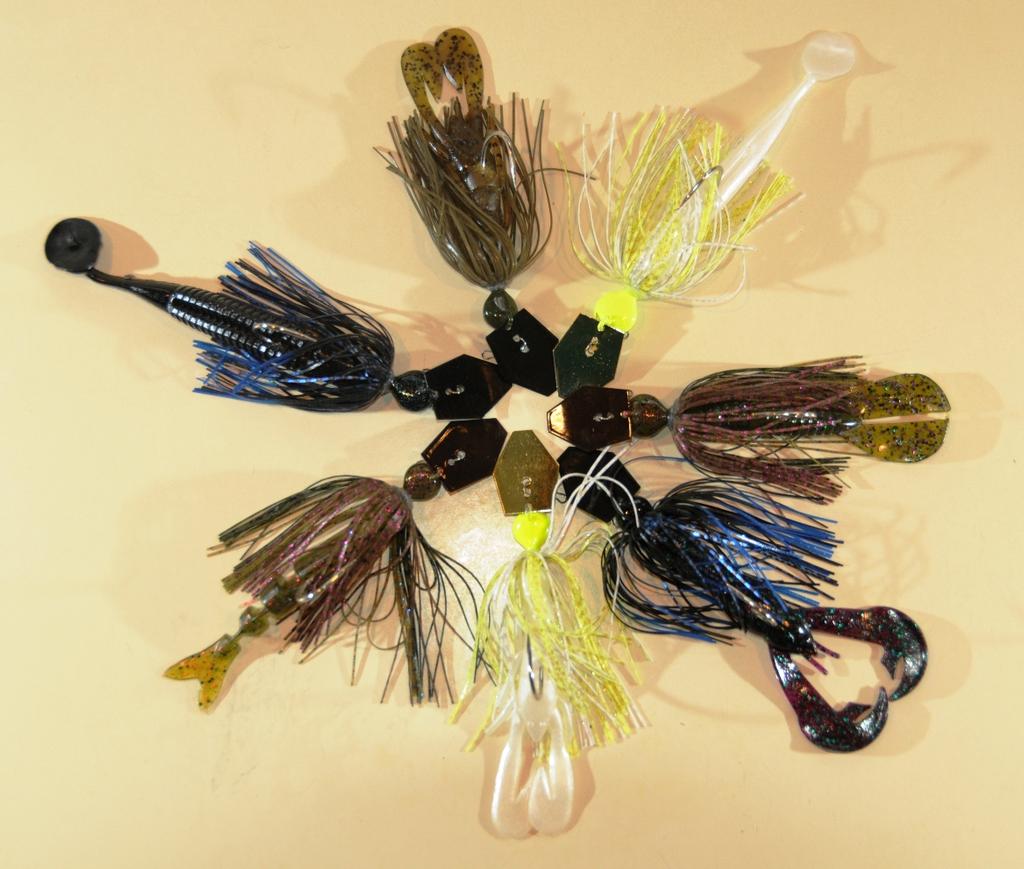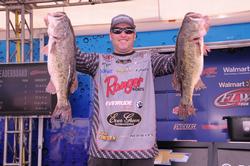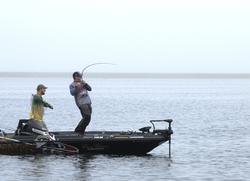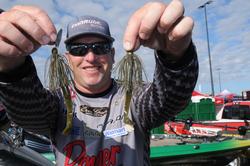The chatter that matters
Chatterbait connoisseur Brett Hite reveals secrets of his favorite big bass technique

One lure, over $400,000 in winnings: that’s the moral of the story for FLW Tour pro Brett Hite, who continues to make bladed swim jigs pay off handsomely in his fishing career.
Several weeks ago, Hite held a Chatterbait up for ransom, yet again, on Lake Okeechobee to the tune of $125,000 for winning the FLW Tour season opener. The victory was Hite’s third $125,000 payday, produced almost entirely on a bait that goes by several names, including vibe jig, bladed swim jig, chatter jig, cranking jig, or it’s commercial eponym, Chatterbait.
East meets West
These days, a ChatterBait Elite is Hite’s go to bait in water less than 10 feet deep, but his infatuation with the lure was not exactly love at first sight.
“Everyone remembers when Bryan Thrift broke out the Chatterbait by winning a tournament on Okeechobee (Rayovac) in 2006,” Hite said. “So of course I had to get my hands on one to try it. The first Chatterbaits came with a little split-tail trailer. I rigged one up with that trailer, threw it out, reeled it in a few times and it just didn’t impress me that much.”
Hite put the Chatterbait on the back burner for a few months until a friend from the West Coast gave him a tip about rigging the new-fangled lure. His buddy suggested ripping the skirt off and putting a full-size swimbait on the Chatterbait instead of the little trailer.
“I was practicing for a FLW Western Series on Clear Lake (2007) and not catching much,” Hite recalled. “I sat down to eat a sandwich and decided to try what my buddy had told me about. So I took a bladed swim jig, removed the skirt and put a big, bluegill-colored swimbait on it. I pulled it through the water a couple of times and liked the way the blade and swimbait combination looked in the water. I fired a cast out there, it hit some grass, I snatched it free and immediately a 5-pounder just crushed it – that’s when the light bulb came on.”
At that moment, two worlds collided for Hite. His extensive background in the western ways of swimbaiting met head on with the square-billed deflection dogma of the east and his new favorite technique was born.
“Once I put a big swimbait on it, it became more of a square-billed swimbait to me,” Hite said. “Combining the realistic look and feel of a plastic swimmer with a the hardcore deflection of a square-bill has become a deadly combination that really has no limitations regionally or seasonally.”
Hite finished 8th in that Clear Lake event in the fall of 2007 and spent the rest of the winter experimenting with various vibe jigs teamed with different swimbaits. When the 2008 season started, he was ready put his new “square-billed swimbait” to work. He promptly won the first two events of that year: a FLW Tour event on Lake Toho and a FLW Western Series on the California Delta. Needless to say, it’s been on his deck ever since.
Prespawn + reaction = big bass

While the Chatterbait has proven to be an incredibly versatile lure that can be used on any type of cover, one of the lure’s sweet spots is the prespawn period in lakes where the predominant cover is vegetation. This is when and where big female bass seem to have a particular penchant for the action of a vibrating jig, giving it the greatest potential to deliver a truly monster bag of bass in a single day.
Hite’s day-one catch of 34 pounds, 15 ounces at Okeechobee this year is an excellent example of this. Also, it has just been revealed that 2014 Bassmaster Classic runner-up Paul Mueller set the single-day weight record for a Classic – 32 pounds, 3 ounces – at Guntersville last week with none other than a ChatterBait Elite teamed with a swimbait trailer.
These are just two recent examples of how deadly the Chatterbait is on big prespawn bass this time of year.
In Hite’s mind, the reason for this is simple.
“It’s a reaction-bite bait, which is deadly on big bass,” Hite offered. “The reaction bite is king in the prespawn when the water is still in the mid 50s. Look at techniques like suspending jerkbaits, lipless rattle baits and even punching vegetation – all three are very effective in the prespawn because they all trigger total impulsive, reaction bites.
Something suddenly snaps or flashes in front of a fish’s face and that fish’s gut reaction is to just inhale it. A Chatterbait snapping out of the grass, deflecting off a piling or ping-ponging off rock triggers the same thing.”
The right equipment

Interestingly, when Hite is prompted to give up the most critical details for Chatterbaiting he starts, not with the lure end, but on the equipment end.
“The rod and line are the most essential ingredients to getting the most from your Chatterbait,” Hite revealed. “Everyone is obsessed with trailers and colors. These are certainly important considerations in matching the forage, but the bottom line is you can have the best Chatterbait in the world, however, using it on the wrong equipment can cost you big bites.”
For starters, Hite never throws a Chatterbait on braided line or pure graphite rods and says using a combination of both prevents the bait from reaching its full potential.
“Don’t get me wrong, braided line and graphite rods will work for a Chatterbait,” Hite says. “But what I’m talking about is going the extra mile to really get the most out of the bait. And to do that, fluorocarbon and a heavy-action glass composite rod are the perfect combination.”
Hite is a major proponent of glass composite rods and fluorocarbon because they improve the castability of the bait and essentially extend the strike zone due to their elasticity.
“Remember, the bait’s magic is its unique ability to deflect or “snap” out of grass, that’s what triggers the reaction bite,” Hite detailed. “Glass composite rods possess a more elastic action that loads up and stores energy in the rod when pulling into a clump of grass or banging into cover. Fluorocarbon provides more stretch than braid, enhancing this elasticity.”
According to Hite, when the bait pops free, the stored energy causes the bait to jettison off the grass in a slower, more forgiving manner, thereby extending the reaction bite period. Since this is the critical moment at which most bites occur, the glass/fluorocarbon combination is more forgiving as the fish tries to inhale the bait.
Illustrating that same process with a faster action graphite rod and stretch-less braid, Hite claims the bait is ripped from the grass too quickly and does not allow near as much “give” during the critical inhalation point, thereby pulling the lure out of the bass’ attack vacuum.
Hite’s personal favorite Chatterbait combo is 20-pound test Sunline Super FC Sniper fluorocarbon on a 7-foot, 3-inch heavy-action Evergreen Heracles Leopard rod, which is a glass composite, teamed with a Shimano Chronarch CI4+ reel.
“The fluorocarbon line and glass composite rod in a heavy action is the way to go,” he reiterated. “And the Chronarch is a 6.2:1 ratio, which is the perfect reel ratio for reeling and snapping Chatterbaits through the grass.”
Bait specifics

As for the lure itself, Hite says the Z-Man ChatterBait Elite in a 3/8-ounce size is his go to for 90 percent of his chattering. The benefits of the Elite version are a bigger hook for bigger fish, a low profile skirt and a pronounced keeper barb that holds soft plastic trailers solidly in place.
Speaking of trailers, what goes on the back of Chatterbait can be vast and varied. These days Hite usually leaves the low-profile skirt on the bait, but he still beefs up his trailer to one of three types of trailers: a swimbait, a shad-type bait or a crawfish with vibrating flappers.
Hite’s plastic trailer selection revolves around Yamamoto Custom Baits’ offerings. His favorite swimbait is a 4-inch Swimming Senko, the shad bait he prefers is a 5-inch D Shad and the craw would be a 3-3/4-inch PsycoDad.
“That’s the other cool thing about the Chatterbait that makes it so unique,” Hite said. “You can easily change the bait’s profile, action and color by using just about any type of trailer you can imagine. You can’t do that with a square-bill or lipless crankbait.”
“Trailers help customize the Chatterbait to the type of forage I am trying to mimic,” Hite continued. “So I am constantly experimenting around with different shapes and sizes as trailers.”
Colors also play a role in forage simulation as well. Hite usually packs three different colors in the rod locker: green pumpkin with a black blade, black blue with a black blade and white/chartreuse with a silver blade.
“Again let the forage dictate your color and trailer package,” he explained. “For instance, at Okeechobee, where I felt bass were feeding on bream and perch, I went with the green pumpkin with a green pumpkin Swimming Senko. I also used a black and blue with black/blue laminate Swimming Senko.”
“But if I’m on more of a shad-based lake like a TVA impoundment or fishing during the shad spawn, I’d go with the white or white and chartreuse with that D Shad-style trailer in a pearl or smoke shad,” he continued. “Chatterbait fishing is really about matching the forage and given all the different plastic shapes and sizes, the sky is the limit on dialing in the forage.”
As a final tip, Hite says if you are worn out after throwing a Chatterbait all day, then you are fishing it correctly.
“It’s a physically demanding bait, which is what I love about it,” Hite said. “You don’t just lob it out there, plop down in your butt seat and creep it along. You want to make the longest casts possible and really attack the cover; be aggressive with it. Try to slam it into anything under the water. When fishing grass, snatch and jerk it out of the grass. And get used to pulling grass off your bait all day – it’s just part of the process. It may sound like work, but when you have 35 pounds packed in your livewell, it’s darn worth it.”
